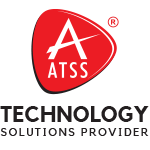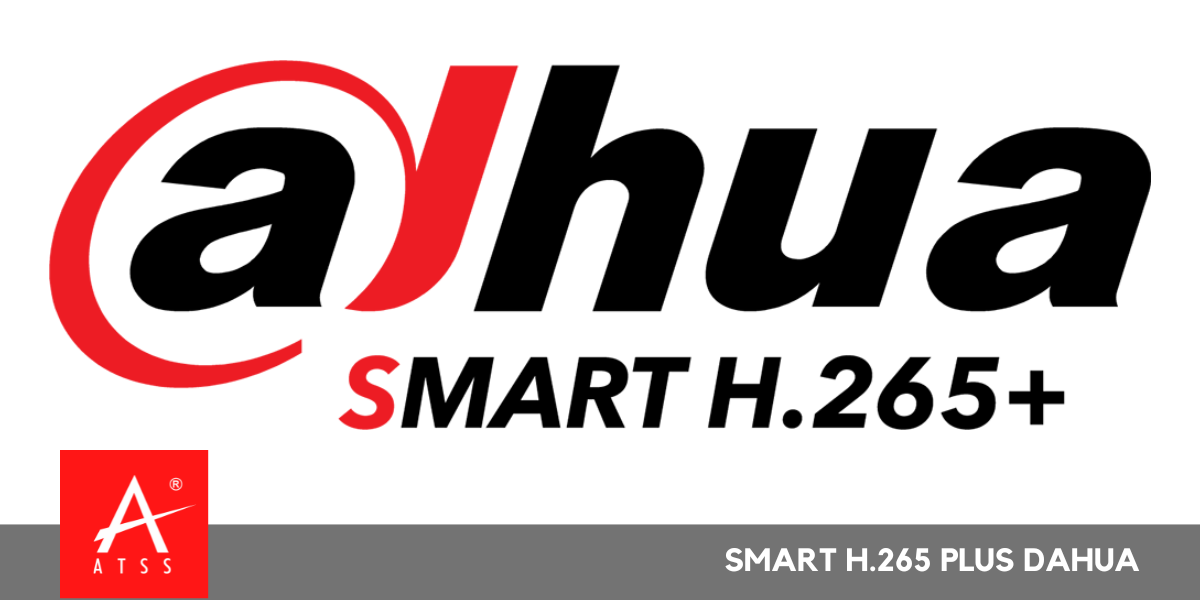
Smart H.265 Plus Dahua
Smart H.265+ – Smart Codec, Lower Bit Rate, Less Storage
Smart H.265+ Introduction
Smart H.265+ is not a new technology, but an optimized implementation of H.265.
Smart H.25+ technology is a collection of intelligent encoding algorithms developed by Dahua Technology based on H.265. To meet the characteristics of video surveillance, Smart H.265+ adopts some key video encoding techniques that can be flexibly added/deleted or combined according to different applications and products. Smart H.265+ codec can effectively enhance video encoding efficiency according to the characteristics of different surveillance environments; furthermore, it can greatly reduce the transmission bit rate, and storage capacity to improve the overall system CAPEX/OPEX.
Background
Typically video surveillance needs to record the video 24/7 and it consumes huge storage. With the surveillance operators pursuing/moving to HD/UHD, the surveillance video of high resolution and large bit rate has become one of the main challenges. It further adds to the storage and transmission cost and increases the whole cost of the surveillance system. Smart H.265+ is to address this issue in a smart way.
To resolve the issues, the surveillance industry players are constantly investing in technologies and innovations to reduce surveillance costs. On one hand, following the latest encoding standard (including MPEG4, H.264, H.265 and etc.,) manufacturers are constantly upgrading and improving their product line so that their products can support the latest technologies and high-efficiency encoding standards. Usually, this target can be realized via hardware development and it may take a long time till the development and maturity level of the hardware ecosystem. On the other hand, H.265/HEVC encoding standards are beginning to have wide adoption in surveillance products hot to improve the compression rate and encoding efficiency further with software upgrades based on the current H.265 encoding standard is one of the new development in the industry.
Compared with other video files, typical surveillance video has the following characteristics.
- During the specified period, the background of the surveillance video is static, or has minor motions.
- In the surveillance video, most of the time the video is static and the moving object/motion appears at the certain periods.
- The surveillance environments usually need 24/7 recording, the noise is generally high, and especially at the night the noise is extremely high.
- Operators are usually only interested in the moving object in the surveillance video.
Key Technologies
Smart H.265+ technology is a collection of intelligent encoding algorithms. It includes many key techniques of encoding technology. Dahua’s newly-developed smart H.265+ includes the following three key aspects :
- Advance bit rate control algorithm
- Video encoding based on the video contents analytics (including dynamic ROI, dynamic ROI, dynamic GOP, flexible reference frame structure)
- Noise suppression technology.
Scene Adaptive Encoding Technology
The Surveillance scene is not fixed. According to the JND model (Just a Noticeable Difference Model), the human visual perception of an object is different. For example, human visual perception of indoor objects is more sensitive than outdoor objects. Adopting a differentiated encoding strategy according to the different scenes can effectively reduce human vision redundancy, thus improving encoding efficiency. For example, a 4M bit rate with indoor objects will have a similar human vision presentation with 1-2M for outdoor projects.
Scene adaptive encoding strategy is to implement a differentiated strategy based on smart scene analysis which includes the analysis of light/noise/motion conditions and enjoinments. The Scene adaptive encoding strategy can not only guarantee the human visual perception of the surveillance scene but also improve the encoding efficiency.
Video Encoding Based on Video Analytics
Dynamic ROI
Generally speaking, surveillance operators are only interested in the moving object in the Surveillance video and have less interest in the background area. With this background in mind, Smart H.265+ implements the strategy of separating moving objects from the background automatically according to the motion in the video scene through video analytics technology. After separation, Smart H.265+ adopts different compression levels according to different ROI. For example, lift the compression level for the background area and lower the compression level for moving objects. For surveillance video, since the moving object only appears in the specified period and lasts for short time, Smart H.265+ can remarkably enhance compression efficiency.
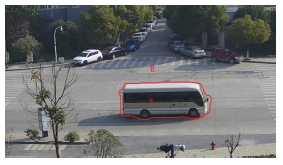
As Shown in the figure above, the Red box is the moving object marked as F, and the other area is the background scene marked as B. Normally only the moving object (F) is the main interesting area and the image quality need to be guaranteed. Following the differentiated encoding strategy described in figure 2 can be adopted to improve the overall performance: quality of moving object F needs to be guaranteed and the quality of background area B can be lowered, thus reducing the bit rate of background area and as a result to lower the overall system transmission bit rate.
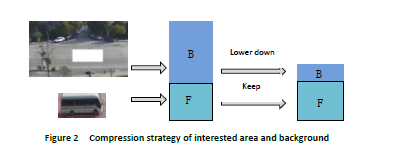
Dynamic GOP
In the Video bit Stream, the frame size of the I-frame is usually times the P-frame size in order to guarantee the video quality. The I-frame has a much bigger storage load in the video bit streams compared with P-frame. Since typical surveillance video is static or has minor changes for the majority of the time, Smart H.265+ adopts the strategy of dynamic GOP and only inserts I-frame when there are big changes and an additional I-frame is necessary. The length of GOP can be adapted dynamically according to the real application in surveillance video. With the dynamic GOP structure (D-GOP) to reduce the I-frame amount in the bit stream, compression efficiency can be improved effectively.
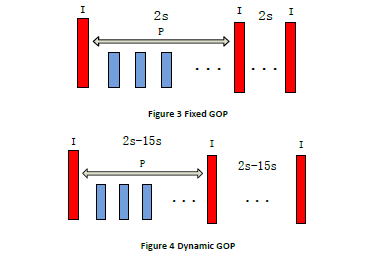
As described in figure 3, a typical surveillance system implements fixed GOP, which means the interval between 2 I-frames is fixed, generally sets as 2 seconds. Keep in mind that in surveillance video, most of the time the video is static and the moving object/motion appears at certain periods, Enlarging the GOP could effectively reduce the amount of I-frame in a set time-period. Only when the motions/moving objects appear, I-frame will then be inserted to ensure the video quality according to the real surveillance scene which is called dynamic GOP. As described in figure 4, reducing the amount of I-frame can reduce the overall system transmission bit rate.
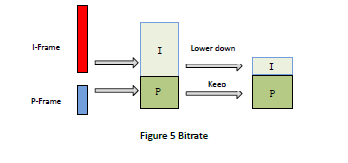
Flexible Reference Frame Structure
To reduce the bit rate and guarantee encoding video quality, compared with the single frame reference structure of standard H.264 and H.265, Smart H.265+ adds a more flexible reference frame structure. It adopts dual-frame reference and virtual I-frame technique.
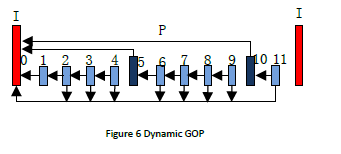
Dual Frame Reference Technique
Ordinary surveillance video encoding only takes a single frame (I-frame or previous frame) as a reference frame. For the dual-frame reference technique, two reference frames will be taken for reference purposes. Besides referencing the previous frame, it takes IDR as a reference frame too. In the above figure, the 2nd P-frame references both the IDR (frame 0) and the 1st P-frame. In the motion scene, compared with the single frame reference, the dual reference structure can find a better reference block for the shielding background zone of the moving object. It can enhance the accuracy of the evaluation and raise compression efficiency.
Virtual I Frame Technique
Generally, only I-frame can realize the random add/insert function. The virtual I-frame technique implementation ensures the P-frame can appoint the previous IDR as the only reference frame (In the above figure, the 5th P-frame can only reference the 0th IDR) so that it can be added/inserted whenever necessary instead of relying on the previous P-frame to decode.
Noise Suppression
The noise of the surveillance video is usually high when the application area is uncertain and the light condition is poor. The noise can not only affect the video quality but consume more encoding bit rate as well. It is necessary to control the noise and implement a better-controlling strategy for video encoding. The traditional noise reduction strategy is generally to take the video scene as a whole and intense noise reduction techniques can delete some video details during noise reduction. It is hard to find the balance between these two factors in traditional noise reduction techniques. Based on the video analytics technology, the Smart H.265+ technology generally separates/distinguishes the motion area from the background area and adopts different noise reduction levels for motion and background (see figure 7). In this way, it can not only reduce the noise but also guarantee the ROI of video quality. Especially for high-noise environment such as surveillance scenes at night, it can greatly improve the encoding bit rate.
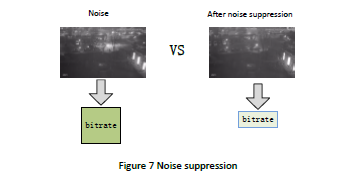
Encoding Efficiency Test
The following table shows the real test results of encoding efficiency with Smart H.265+ enabled compared with Smart H.265+ Disabled.
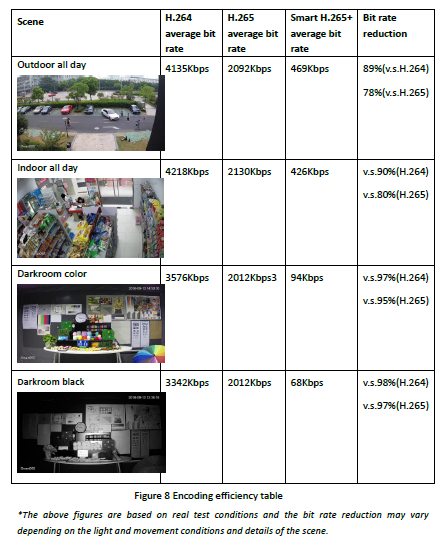
Application Areas
Smart H.265+ is a collection of intelligent encoding algorithms and contains many encoding techniques. To ensure that it can be widely used in various products across different platforms, the key techniques can be added/deleted on combined flexibly according to the real application with different products or platforms. For different motion surveillance environments, Smart H.265 can generally enhance the compression rate. Generally speaking, the improvement rate of compression efficiency is high if the contents in the surveillance scene are simple and the amount of moving objects is small. Since Smart H.265 is developed based on the H.265 standard, the Smart H.265+ encoding compression rate is as good as the general H.265 encoding even in an extreme environment.
Smart H.265+ technology is developed based on the H.265 standard. Most existing hardware and software can play its bit streams. To enjoy a better playback experience, the decoder is able to support Smart H.265+ bit streams with minor modifications required.
Smart H.265+ refers to the collection of intelligent encoding algorithms. It is not in any way a new video encoding standard but an optimized implementation of the H.265. Many Techniques of Smart H.265+ are beyond the video encoding standard framework which ensures the Smart H.265+ technology does not conflict with the H.265 encoding standard. Or the other hand, its key techniques can be applied to H.265.
Conclusion
Based on the Current H.265 Video encoding standard, Smart H.265+ adopts some available video encoding techniques and integrates these key techniques with Dahua’s advanced video content analytics technologies. It effectively improves video encoding efficiency while guaranteeing video quality at the same time. The Smart H.265+ technology does not require a hardware upgrade or replacement, but a firmware upgrade which can greatly enhance the product features without adding additional cost.
R.Nandakumar-ATSS
